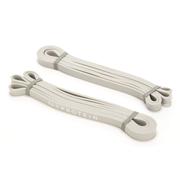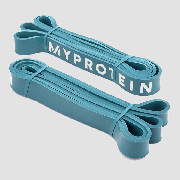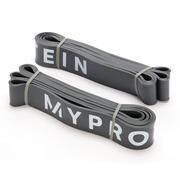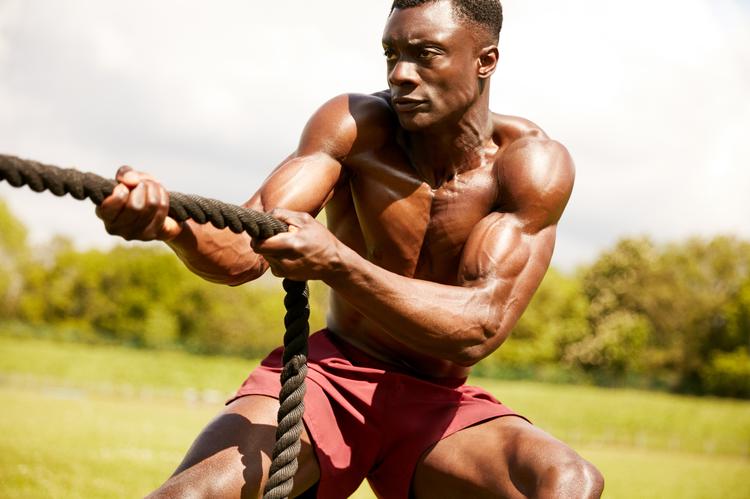Light Gray Resistance Bands (2-16kg resistance)
These bands are perfect for beginners or smaller movements. If you are just getting started, we recommend that you use these. They are great for curls for biceps and triceps extensions, or they can be bent to make “gluteal bridges” – they will make your muscles “burn”.

Blue Resistance Bands (11-36kg resistance)
If you want to increase the level of difficulty in your training, use these bands. They are the next step after the light gray bands, and they will provide the extra effort you need to get results.

Dark Gray Resistance Bands (23-54kg resistance)
These bands are perfect to perform the biggest movements at home. They provide the highest level of resistance, and can be used for large compound exercises, such as squats and deadlifts .

Training With Resistance Bands
Here are some of our favorite leg exercises. Altogether, eight exercises to try. Bands ready, headphones on the ears and hands to work.
1. Bulgarian Split Squats (Bulgarian Squats)
Targeted Muscles: Quadriceps, glutes.
This one-sided squat is a fantastic way to develop strength and muscle in each leg individually, and to develop mobility in the hips. It will also test your balance and coordination.
- Place one foot on a solid surface behind you a step away. A chair or bench is good for this purpose.
- Keeping your back straight, lower your body slowly, until your front knee is bent at a 90 degree angle.
- Pause at the bottom of the movement, then go back up to the starting position.
The position is very important. If you are too close to the bench, you may experience knee pain, but if you are too far away, you will put too much effort in the groin. Make sure the front knee doesn’t go beyond the toes and remember to keep the core active and the back plumb.
2. Stiff-Leg Deadlifts (Extended Legged Groundlifts)
Target Muscles: Hamstrings, lumbar, buttocks.
The deadlifts with extended legs are an isolation exercise, and excellent when used in addition to the large lifts, such as squats and regular deadlifts . They target the hamstrings and glutes, as well as the lower back and core.
- Position yourself on top of the resistance band, grab both ends of the band and assume the starting position.
- Folding your body from your hips, lean forward, keeping your knees slightly bent throughout the movement.
- Let the band slide along your legs, keeping your back straight and your spine in a neutral position.
- Pull your hips back and lower the band as far as possible, until you feel the hamstrings “stretch”.
- Go back up until you return to the starting position.
The wider the distance between your legs, the more resistance you will feel. It is therefore very easy to increase and decrease the difficulty in meeting your needs. It is also a good exercise to stretch tense hamstrings after an intense leg session.
3. Standing Kickbacks (Rear Kicks)
Target Muscles: Buttocks and Hamstrings.
Kicks to the rear from the upright position will work the three gluteal muscles, also mobilizing the hamstrings as a secondary muscle.
- Place the band around the legs, immediately above both ankles.
- Keeps the body stable and reduces torsion by activating the core.
- Kick back, in a slow motion, tensioning the gluteus 1 second each time.
- Keeps the knee slightly flexed throughout the movement.
- After you have finished all the repetitions on one side, switch legs.
One of the benefits of using the bands is that they provide the muscles with resistance throughout the movement. There is no resting point, so the glutes remain activated for longer. Remember to keep the tension on the band and try not to rest your foot throughout the exercise.
4. Single-Leg Hip Thrust (Unilateral Hip Thrust)
Targeted Muscles: Buttocks and core.
The Hip Thrust Unilateral is an advanced variant of the regular hip thrust , so it is best to try it out without using any additional resistance first. This is because using only one leg creates instability, which can cause you to lose your balance.
- Fasten each end of the resistance band under each foot, and the loop around the upper leg.
- Sit your back against a bench, step or chair, with one knee flexed and your foot flat on the floor.
- Lift your other leg and bend your knee so that your hip and knee form a 90 degree angle.
- Push with the leg and contract the glutes, lifting the hips until they are aligned with the torso.
- Go back down to the starting position. This counts as a repetition.
This variant is the perfect way to fix any imbalances of strength in the development of the lower body, as well as a challenge for the core, by lifting one leg at a time.
5. Kneeling Kickbacks (Rear Kicks In Kneeling Position)
Target Muscles: Buttocks, hamstrings.
Kicks to the rear are a fantastic exercise for the lower body that helps to develop and strengthen the glutes. These are among the largest and strongest muscles in the body, responsible for ensuring the stability of the pelvis and the movement of the hips.
- Position yourself on all fours, aligning your wrists with your shoulders and your knees with your hips.
- Secure the resistance band in the middle around one foot and place the tips under the palms of the hands, to hold it firmly.
- Without changing the knee angle, extend the leg back and up until the thigh is parallel to the floor.
- Contract the glutes at the top of the movement and hold that position for a moment.
- Return to the starting position without touching your knee to the floor and repeat.
- Change legs and repeat the steps above.
When you extend the leg that has the band to the rear, you may need to change the knee angle to 45 degrees to prevent the band from slipping.
6. Walking Squats (Squats In Progress)
Targeted Muscles: Buttocks, quads, hips.
You will feel this exercise working the distal part of your hips and thighs. For a more intense workout for quads, perform the exercise from a deeper squat position.
- Place a band with low or medium resistance around both legs, just above the ankles.
- Lower yourself until you are in a squat position; lower yourself as much as possible, but not so much that you are in an uncomfortable position.
- Take two steps to the side and lower yourself to another squat.
- Make sure the band is tense throughout the exercise.
Try to keep your body weight well centered, the core active and the band in constant tension throughout the movement. You can also try tying the band around your thighs, just above your knees.
7. Fire Hydrants (Hip Abduction)
Target muscles: Hip abductor muscles, which include gluteus medius, gluteus minimus and tensor fascia lata.
Hip abductors, or “fire hydrant” exercise, are a body weight exercise. They mainly work the gluteus maximus, but some variants also mobilize the core. They help to sculpt the glutes.
- Place the resistance band around the legs, just above the knees.
- Place yourself on your hands and knees on the floor, with your hands aligned with your shoulders and your knees aligned with your hips.
- Lift one leg away from the rest of the body, lifting the left knee to the side. It is important that you keep the core active so that the body does not rotate during movement.
- Bring the leg back to the starting position. This counts as a repetition.
- After you have finished all the repetitions on one side, switch legs.
The mini-bands are excellent for this exercise! But if you don’t have one at home, there’s no problem: just fold your band in two.
8. Glute Bridges
Targeted Muscles: Buttocks, core, hips, quadriceps.
Buttock Bridges are one of the most effective exercises for toning the glutes and hamstrings. This movement to the lower body isolates and strengthens the glutes, hamstrings, core, hip muscles and lumbar muscles.
- Place both ends of the band around the feet.
- Lie on your back, with the band above your knees, secure on your thighs, with your feet shoulder-width apart.
- Use upward force, contracting the glutes at the top of the movement for 1 or 2 seconds.
- 15-20 repetitions provide a good sweat to finish the workout with a flourish.
The gluteal bridge is an incredible way to strengthen the core and lower back muscles, in addition to the glutes and hamstrings. It is also an excellent way to end training.
Final Message
Whether you can go to the gym right now or not, there is no excuse for missing your day on legs. With these eight resistance band exercises for your legs, you’ll find that resistance band training can be just as effective.
When looking for resistance band exercises for your legs, don’t forget these ideas. Through the use of several compound movements, you can make the most of the potential of the resistance bands, requiring only a minimum of equipment and space.
So, whatever the obstacles that get in your way, you don’t need to let them stop you from achieving your goals. Resistance bands are another valuable tool at your disposal.



Be First to Comment